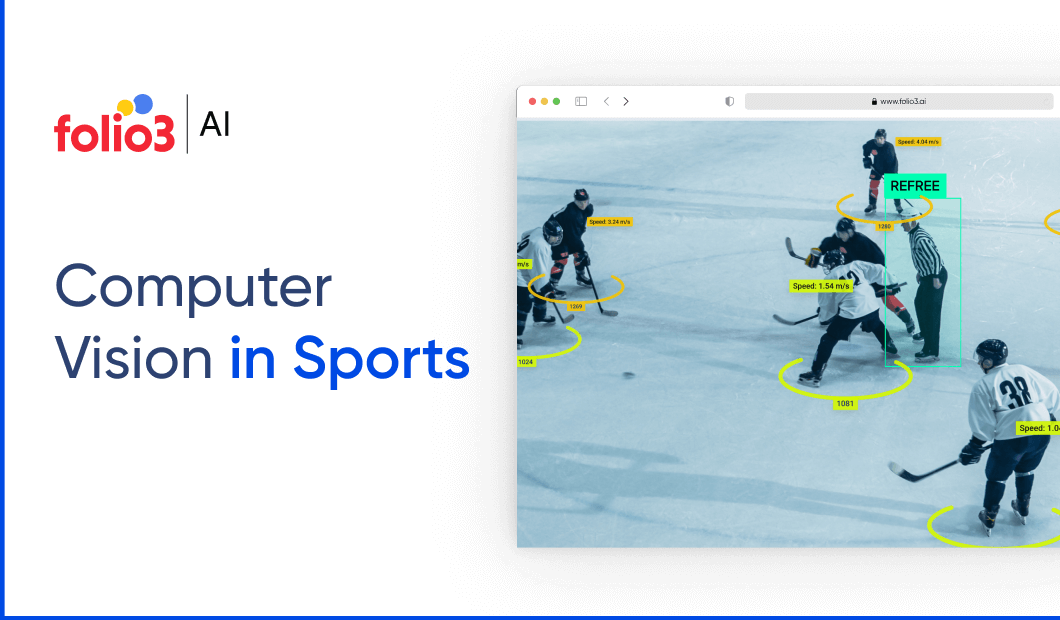Sports have always been a positive activity in our daily lives. Their growing traction and popularity have made them a crucial extracurricular component in many organizations, benefiting employees both physically and mentally.
Some organizations include sports to help employees take a break and recharge. In fact, sports is one of the fastest-growing industries, where AI and computer vision have been incorporated to meticulously track every gameplay dynamic, analyze real-time performance metrics, and evaluate team cohesion and tactical play patterns.
Computer vision in sports, working synergistically with cameras, provides granular insights into every game aspect. Let me illustrate with a compelling example that truly showcases the power of computer vision.
- A great example is the Hawk-Eye system used in tennis and cricket. In tennis, multiple high-speed cameras track the ball’s trajectory in real-time, allowing for precise line-calling and player movement analysis. Similarly, in cricket, Hawk-Eye maps ball trajectories to assist umpires with LBW (Leg Before Wicket) decisions.
- Another example is the VAR (Video Assistant Referee) system in football, which uses AI-driven camera feeds to review goals, fouls, and offside decisions with extreme accuracy. By analyzing player positioning and ball movement frame by frame, VAR helps referees make more precise calls, reducing human error.
These examples show how computer vision’s detailed game analysis helps coaches and teams make data-driven decisions. It levels up performance by 20%, and VAR has cut referee errors by 98%. Very potential, right? Keep reading to see how various computer vision applications and their impact across multiple sports.
Key Applications of Computer Vision in Sports
1. Player Tracking and Performance Analysis
Player tracking and performance analysis are among sports’ most crucial computer vision applications. They change perceptions of athletes’ approaches to training and competition. This technology employs sophisticated algorithms and high-resolution cameras to monitor real-time player movements, capturing data on speed, acceleration, distance covered, and more.
By gathering and analyzing this valuable information, coaches can pinpoint individual players’ strengths and weaknesses. This allows for tailored training programs that focus on specific areas for improvement.
Also, the computer vision algorithmic approach facilitates the analysis of tactical patterns, helping teams devise effective strategies based on gameplay dynamics. Teamwork is key in sports, where player tracking and performance help prevent injuries by tracking movements. Overall, computer vision amplifies performance and elevates athlete training to the next level.
2. Automated Officiating and Referee Assistance
Automated officiating and referee assistance is an increasingly common application of computer vision in sports, helping to ensure fairness and accuracy in games. Computer vision systems analyze vast amounts of data in real-time, far exceeding the capabilities of human referees.
Key aspects of this technology include:
- Ball tracking: It assists in determining whether a ball is in or out of bounds, resolving questionable calls with accuracy down to the millimeter.
- Automated refereeing: Computer vision can support decision-making processes during games, reducing the reliance on human judgment. Various sports can use automated systems to ensure games are conducted fairly.
- Next Gen Stats: The NFL uses a computer vision system called “Next Gen Stats” to track the location of every player on the field, aiding officials in making informed decisions, such as penalty calls.
- AI-powered VAR system: AI and computer vision are being integrated into Video Assistant Referee (VAR) systems to improve the accuracy and speed of decisions. These systems use image segmentation, object detection, and motion analysis to trackball trajectories and player positions. Augmented reality (AR) and virtual reality (VR) could be integrated into VAR systems to provide more comprehensive viewing options for referees.
3. Ball Tracking and Trajectory Analysis
Ball tracking and trajectory analysis, powered by computer vision, are essential for extracting information from ball-based sports like tennis, cricket, and badminton. Computer vision models record ball movements in three dimensions, show exactly where a ball hit the ground, and predict its future trajectory.
Key functions of ball tracking systems include:
- Ball detection: Identifying the ball’s presence in each video frame.
- Trajectory tracking: Recording the ball’s movement in three dimensions. Systems like Hawk-Eye use high-speed cameras to track the ball’s trajectory, displaying its most likely path as a moving image.
- Game results prediction: Predicting game outcomes and enabling detailed analysis of ball movement, which helps players improve their skills.
Challenges occur in sports like basketball, volleyball, and soccer, where the ball may be hidden or interactions are rapid. High-resolution cameras and machine learning create 3D representations of the ball’s trajectory, allowing systems to determine if the ball is in or out with millimeter accuracy.
4. Injury Detection and Prevention
Advancements in computer vision technology have significantly benefited sports injury detection and prevention. High-resolution cameras integrated into the right places monitor athletes’ movements in real time, identifying patterns that may indicate potential injury risks.
Take, for example, an athlete who consistently exhibits improper landing techniques after jumps, and the system can flag this behavior as a risk factor for injuries like ankle sprains or ACL tears.
Teams such as the Detroit Pistons employ these technologies to analyze player movements during practices and games, allowing coaches to adjust training regimens proactively to mitigate injury risks.
Additionally, integrating wearable sensors with computer vision improves this capability by providing comprehensive data on biomechanics and movement efficiency, enabling tailored injury prevention strategies for each athlete. This proactive approach not only aids in reducing injury occurrences but also supports athletes in maintaining optimal performance levels throughout their careers.
5. Fan Engagement and Augmented Reality
Augmented Reality (AR) is changing the game for fan engagement in sports, creating immersive experiences that connect fans with their favorite teams in a whole new way. With AR, fans can see live stats, player info, and even interactive content, whether they’re in the stadium or watching from home.
For example, fans can watch personalized stats appear next to players or view replays from multiple angles, making the live event experience more exciting and insightful.
AR is also impacting how sports broadcasts engage viewers. Studies show that AR features can increase viewer engagement by 15% and boost retention by 20% during big events. Plus, AR is helping fans connect with each other, as they can capture and share their unique experiences, building a strong sense of community.
As wearable AR tech becomes more accessible, we’re seeing more personalized fan experiences that keep sports relevant and engaging for all audiences.
6. Tactical and Strategy Analysis
Tactical and strategy analysis with computer vision is really a better version together. It gives teams a fresh way to understand the flow of the game and fine-tune their strategies. Using advanced cameras and machine learning, computer vision tracks player movements, ball trajectories, and formations in real time, giving coaches and analysts key insights.
For example, it can break down player positions during certain plays, showing how teams are working together. This helps coaches craft better game plans, make real-time adjustments, and design focused training sessions.
Plus, by reviewing past games, teams can predict how certain strategies might play out in the future, improving their decision-making and game performance. It’s all about gaining that edge and understanding the game like never before.
7. Motion Analysis for Training Optimization
Motion analysis is all about uplifting the team to boost performance and keep injuries at bay. Techniques like skeletal motion analysis track an athlete’s movements to check their form during training. We can make sense of all complex motion data by using deep learning methods, like Transformer networks and Graph Neural Networks (GNNs).
This helps coaches spot bad techniques that could lead to injury. Looking at joint movement and patterns gives athletes feedback to fine-tune their training. Plus, Generative Adversarial Networks (GANs) make realistic motion sequences for even better practice. In the end, it’s all about improving performance while keeping athletes safe.
8. Automated Highlights and Content Generation
Automated highlights are totally changing how people interact with sports media. AI and machine learning pull out the big moments, like goals or fouls, from live or recorded footage, and bam, you’ve got content.
Here’s the computer vision aid in this:
- Quick Content Creation: AI whips up highlights fast, so media outlets can keep fans engaged across all platforms.
- Personalized Clips: It looks at what viewers like and generates custom highlight reels, making the fan experience way better.
- Real-Time Action: AI can actually create highlights while the game’s still going, giving fans instant access to key moments.
- Data Insights: It also grabs engagement data, helping companies improve content for next time.
- Talent Spotting: AI checks out game footage to spot rising stars for recruitment.
Basically, AI makes content creation smarter, faster, and more engaging, giving media companies a serious edge.
9. Virtual Advertising and Sponsorship Analytics
Virtual advertising lets teams insert targeted, dynamic ads into broadcasts, catering to local and national markets based on viewer location and platform. This expedient revenue opportunities, especially during global events like the World Cup.
Sponsorship analytics solutions take this further by offering insights into fan behavior, including in-stadium purchases and attendance data. With these analytics, sports organizations can craft precise marketing strategies that engage specific fan demographics, making sponsorships more effective and strengthening brand connections.
Emerging tech like augmented reality (AR) and non-fungible tokens (NFTs) are pushing virtual advertising boundaries, creating new ways to engage both in-person and digital fans. As sports evolve, integrating these tools will be key for maximizing revenue and enhancing fan experiences.
10. Biometric and Facial Recognition for Security
Biometric and facial recognition technology is taking security to the next level by using unique biological traits like fingerprints, iris patterns, and facial features for identification. Unlike passwords, which can be hacked or forgotten, these systems are much harder to bypass.
Facial recognition works by analyzing facial features from images or videos and matching them with stored data. It’s widely used for monitoring access to secure areas and identifying people in real time. Many businesses rely on this tech to track who’s entering and leaving and even alert security if someone flagged is detected.
When AI is added to facial recognition, it alleviates accuracy and speeds up processing, making tasks like check-ins and attendance tracking much smoother. But, it’s important to handle the data carefully to avoid privacy issues and stay compliant with regulations.
Frequently Asked Questions
What Is Computer Vision in the Olympics?
It’s used to track athletes’ movements, analyzes their performance in real time, and provide accurate data for broadcasts and judging.
How Is Computer Vision Used in Sports?
It helps with player tracking, game analysis, injury prevention, and instant replay for better decision-making and fan engagement.
What Is Computer Vision in Tennis?
It’s mainly used to track the ball’s path during matches, ensure accurate line calls, and enhance the player’s strategy through data.
Final Words
We have already seen the sports industry thriving with AI; almost every game, whether basketball or volleyball, requires AI and computers, offering profound impacts on performance analysis, fan engagement, player health, and officiating accuracy, allowing the team to play like a pro.
One of the most critical applications is in performance analysis. Teams use computer vision to track players’ movements, analyze their techniques, and identify areas for improvement. This technology facilitates a deeper understanding of athletic performance, allowing coaches to tailor training regimens and game strategies based on quantitative data.
This ongoing evolution makes computer vision not only a valuable asset today but also an indispensable part of sports’ future, driving innovations that will refine every aspect of athletic competition.

Areeb is a versatile machine learning engineer with a focus on computer vision and auto-generative models. He excels in custom model training, crafting innovative solutions to meet specific client needs. Known for his technical brilliance and forward-thinking approach, Areeb constantly pushes the boundaries of AI by incorporating cutting-edge research into practical applications, making him a respected developer in folio3.









